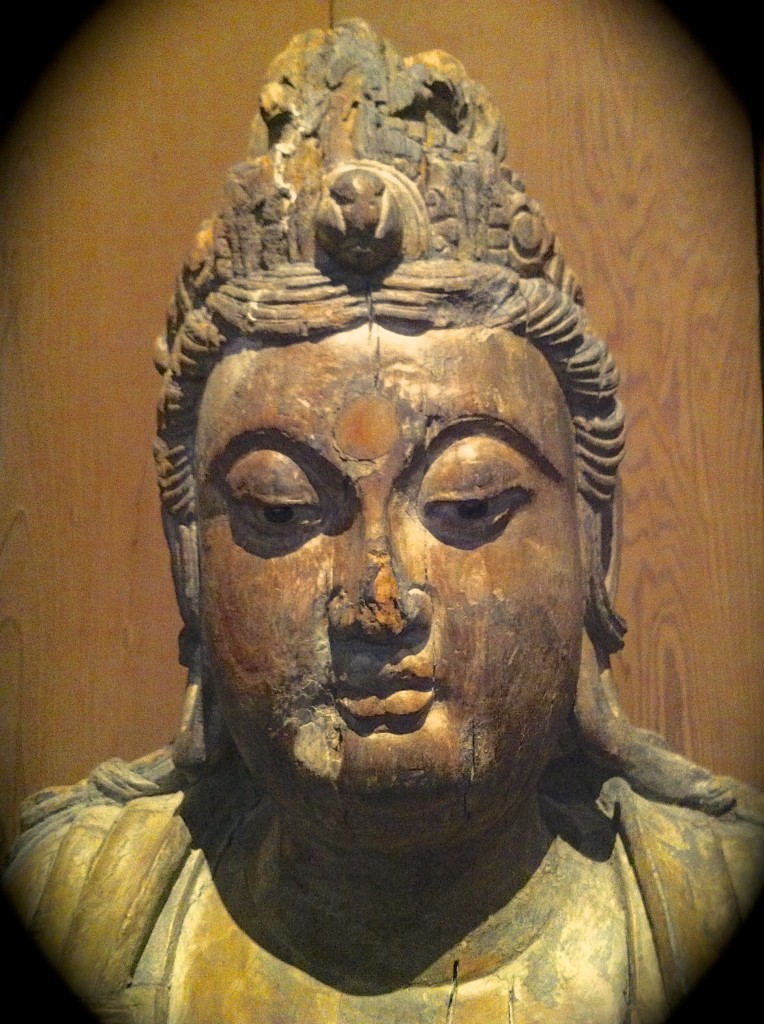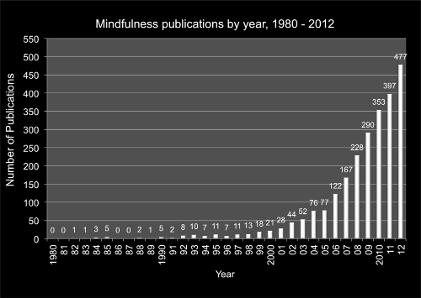 Mindfulness has taken an awful lot of flack lately with critics piling on from all quarters. There seems to be a kind of Thermidorian reaction, a counter-swing of the pendulum, in response to the successful dissemination of mindfulness-based techniques throughout society, not only in medical settings and schools, but in corporations, prisons, and the military. Some of the flak is from Buddhist scholars who question mindfulness’s emphasis on ”bare” and ”non-judgmental” attention, pointing out that mindfulness can be either ”right” or ”wrong” mindfulness depending on whether it’s accompanied by clear comprehension and discerning wisdom. Others worry that mindfulness is being merchandized while failing to anchor it to an ethical frame, or that it’s being deployed as a handmaiden to corporate capitalism, exacerbating complacency and inequality, or that it’s diluting the Dharma, making people merely comfortable instead of transforming or enlightening them.
Mindfulness has taken an awful lot of flack lately with critics piling on from all quarters. There seems to be a kind of Thermidorian reaction, a counter-swing of the pendulum, in response to the successful dissemination of mindfulness-based techniques throughout society, not only in medical settings and schools, but in corporations, prisons, and the military. Some of the flak is from Buddhist scholars who question mindfulness’s emphasis on ”bare” and ”non-judgmental” attention, pointing out that mindfulness can be either ”right” or ”wrong” mindfulness depending on whether it’s accompanied by clear comprehension and discerning wisdom. Others worry that mindfulness is being merchandized while failing to anchor it to an ethical frame, or that it’s being deployed as a handmaiden to corporate capitalism, exacerbating complacency and inequality, or that it’s diluting the Dharma, making people merely comfortable instead of transforming or enlightening them.
As for myself, I’ve never had a problem with the idea of diffusing Buddhist-derived practices throughout the larger culture; half a loaf is better than none. Nor have I ever been much of a purist; we Zen practitioners can’t afford to be. Contemporary Zen is, after all, as syncretic as a religion can get — a tasty and at times confusing mÁ©lange of Indian, Chinese, Japanese, and modern Western influences. So if Jon Kabat-Zinn’s definition of mindfulness — paying attention on purpose, in the present moment, non-judgmentally — doesn’t entirely map onto the ancient Pali word ”sati,” but betrays other influences — some based on misinterpretation, some imported from Buddhist modernist or non-Buddhist sources — so be it. The word ”mindfulness” has stuck, and now means, Á la Lewis Carroll’s Humpty Dumpty, ”just what we choose it to mean, neither more nor less.” The more important question isn’t semantic, but empirical: Is mindfulness, as currently construed, useful or not? Does it reliably and meaningfully impact matters that human beings care deeply about, things like the perennial Buddhist concerns of sickness, old age, and death? As a science writer for the Mindfulness Research Monthly, I get to sample the approximately forty or so scientific papers that are published on mindfulness each and every month. I usually don’t comment on them here, but some recent findings may help illuminate the question.
So just how useful is mindfulness? Let’s start by looking at mindfulness and suffering, and let’s start with a very specific kind of suffering: physical pain. Jon Kabat-Zinn’s fabled 1982 study of mindfulness’s ability to reduce pain in chronic pain patients was the very first scientific study of mindfulness. It was a pilot demonstration, nothing more, conducted on a shoe string — no NIH grants, no randomization, no controls. It proved precious little on its own, but it was enough to suggest that mindfulness was worth a second look, that it needed to be explored using better, more expensive, more sophisticated methodologies. It opened the floodgates to an enormous outpouring of thirty years of subsequent research.
So where does the science of mindfulness and pain reduction stand today? Joshua Grant from the Max Planck Institute for Human Cognitive and Brain Sciences recently reviewed the research on the neuropsychology of meditation and pain [ref] Grant, J. (2013) ”Meditative analgesia: the current state of the field.” Annals of the New York Academy of Science, DOI: 10.1111/nyas.12282 [/ref] What did he find out? First, that one could compare the efficacy of focused attention (e.g. shamatha, mantra practice, anapanasati) and open monitoring (e.g., vipassana, shikantaza, choiceless awareness, dzogchen) as to their respective abilities to reduce pain, and when one does so, the evidence for open monitoring is much better than that for focused attention. While there’s some evidence that a very skilled yogi practicing focused attention can suppress somatosensory cortical response to pain through a process of distraction, there’s precious little evidence that the average meditator can do so. On the other hand, there’s mounting evidence from three independent laboratories that open monitoring reduces pain sensitivity and related suffering, and does so in a consistent way. Unlike focused attention, open monitoring doesn’t suppress somatosensory cortical responding, but actually enhances it (along with insula and anterior cingulate responding). Instead, it decreases the prefrontal lobe activity associated with elaborative mental processes (e.g., mental narratives, cognitive appraising, and self-involvement) that exacerbate pain. A study of experienced Zen practitioners showed that they exhibited decreased functional connectivity between these brain regions — as if they had developed a way to decouple their sensory perception from their elaborative mental activities — and that the greater the decrease in functional connectivity between these regions, the lower their pain sensitivity. The really interesting thing here is that this neuropsychological account agrees completely with what mindfulness teachers have been saying all along about what mindfulness ought to and does accomplish — that it increases bare attention to sensation while helping the meditator to drop his or her self-involved story line.
Now let’s examine another topic — aging. UCLA neuroscientist Eileen Luders [ref] Luders. E. (2013). ”Exploring age-related brain degeneration in meditation practitioners,” Annals of the New York Academy of Sciences, DOI:10.1111/nyas.12217 [/ref] recently reviewed the evidence that meditation protects the brain against the effects of normal aging. She summarized the results from three independent studies that compared age-related brain changes in meditators and non-meditators. These studies found 1) a smaller age-related decline in gray matter volume in Zen meditators, 2) a smaller age-related decline in right frontal cortical thickness in vipassana meditators, and 3) a smaller age-related decline in white matter connectivity in a group of vipassana, Zen, and shamatha meditators.
Now some might point out that these studies used Zen, vipassana, and shamatha meditators — Buddhist practitioners all. They might wonder whether the same results would hold true for secular mindfulness practitioners. The answer is that it does. Harvard neuropsychologist Britta Holzel and her colleagues [ref] HÁ¶lzel, B., Carmody, C., Vangela, M., Congleton, C., and Yerramsetti, S., Gard, T. and Lazar, S. (2010). ”Mindfulness practice leads to increases in regional brain gray matter density,” Psychiatry Research: Neuroimaging, 191 (2011) 36—43 [/ref] found that a standard 8-week Mindfulness-Based Stress Reduction course resulted in significant increases in gray matter density in the left hippocampus, posterior cingulate cortex, temporo-parietal junction, and cerebellar vermis. And that was the result of just an eight week course! The take away is that mindfulness meditation — whether Buddhist or secular — is good for your brain.
But what about the other objections I referred to at the beginning of this post? Is mindfulness guilty of making people happier without making them Enlightened?
You bet. Guilty as charged. There’s an awful lot of suffering in the world, and if we care deeply about our Bodhisattva vows, we want to see others suffer less. We really do. Buddhism isn’t just about Enlightenment. It’s about suffering and the end of suffering. Buddhism has always had an assortment of goals for people with different needs, in different sets of circumstances, or with different levels of aspiration. Down though the ages most nominal Buddhists have chosen to pursue better karma and rebirth rather than aiming for Enlightenment. If mindfulness only results in happier human beings, then — once again — so be it. Those of us who choose to pursue awakening and transformation can still do so, happily untroubled by the sight of all those cheerful, mindful people milling about in our vicinity.
I’m also underwhelmed by neo-Marxist carping about mindfulness turning workers into complacent zombies, uncritically accepting of the status quo. I can still recall one of my earliest teachers, Larry Rosenberg, saying that if a truly mindful person was meditating in a burning building, he wouldn’t be sitting there mentally noting ”warm, warmer, hot, hotter….” He’d be the first person noticing fire and helping others out the door. During my internship at the Center for Mindfulness we were taught a four-step process adopted from Angeles Arrien’s Four-Fold Way: 1) show up, 2) pay attention, 3) speak your truth/do what’s necessary, and 4) let go. I’ve always considered those four steps to be very the essence of mindfulness practice, and it’s a recipe for wise engagement, not passive acceptance and complacency.
Finally, it’s not been my experience that mindfulness is usually taught untethered to an ethical context. While that context may not be overt and explicit— there isn’t any moralizing in MBSR— it’s implicit in mindfulness’s heartfelt emphasis on compassion towards oneself and others, whether as modeled by the mindfulness instructor in interactions with the students, or as practiced by the students themselves in lovingkindness meditation.
I don’t mean to imply that all of these criticisms are baseless. If there are mindfulness teachers out there who aren’t emphasizing compassion and lovingkindness, or who aren’t encouraging their students to exercise wise judgment after getting in touch with the fullness of the present moment — and who knows, it’s a big world out there, maybe there are — they are hereby put on notice: Get with the program. But we should remember that, as Jon Kabat-Zinn once said, ”mindfulness” isn’t just ”paying attention in the moment.” It’s a placeholder term for an entire secularized version of the Dharma. Is it the Buddhadharma in full? No. But it’s a near enough relative — a close second cousin — and I wish it continued good fortune, and it’s continuing successful diffusion into Western culture.


Hi there, I enjoyed this post very much, it was so reaffirming. I’m a vipassana practitioner and feel the benefits too.
I have my own magazine style blog that features healthy vegan recipes, tips on green living, stress reductions, plus editorials on relevant current affairs and lifestyle content. Have a look at:
http://www.diaryofahomebody.com
I am wondering if I could repost this article on my blog for my readers, they would really appreciate it. I would of course give you full author credit, plus add any biographical information you send me and a link back to this blog too.
I hope to hear from you, and that we can come to an arrangement that suits you.
all the best
Susan
Hi, Susan, Glad you liked it. This blog has a Creative Commons license, meaning that anyone is welcome to share what’s written here as long as there is proper attribution. Link-backs are always appreciated!
Fantastic post. I really enjoyed reading that.
I have just stumbled upon your site and am so impressed with your quality writing (and your attentiveness to commenter!)
I am a nurse with 28 yrs experience working in a major emergency department in Australia. I try to practice Zen as best I can (no teacher) and promote mindfulness as a way to improve nursing practice (see here: http://thenursepath.com/2013/10/18/mindfulnurse-prologue/)
Im off now to browse back through your earlier posts. Hope to read more from you soon. Take care, Ian.
Thanks for visiting the site, Ian! By the way, you are definitely not obnoxicated (hope I’m using the word correctly)!
Found this really affirming and encouraging; even more so the 4 step process [1) show up, 2) pay attention, 3) speak your truth/do what’s necessary, and 4) let go] to be an especially helpful concept for bridging the gap between practice and application. Thanks!
Glad you found this post useful, Carol. The four step process has the virtue of being both simple and profound — it’s the pith instruction for how to infuse mindfulness into our day-to-day interactions with others.
Hi. having just come across your site for the first time, may I re-affirm Ian’s opening comments. Great stuff and keep up the good work!
With reference to the ongoing debate as to the relative merits of focused attention versus open monitoring meditation techniques, can I bring to your attention the comments of Ajahn Chah, one of 20th Century’s greatest Buddhist teachers. He pointed out that these are like two ends of the same stick and hence mutually reinforcing.
Also in Ajahn Chandako’s treatise, ‘A Honed and Heavy Axe – Samatha and Vipassana in Harmony’, that in the context of Buddhist meditation practice the weight of the axe may be compared to serenity (samatha), its sharpness to insight (vipassana), which together in meditation play mutually supportive roles in awakening beings to the nature of reality and releasing them from suffering.
Certainly my own experience is that by developing a strong focused attention, primarily my means of anapanasati at the beginning of meditation, that the follow on open attention/vipassanna practice within the same meditation session is much more powerful and productive – and that finishing with a loving kindness/metta meditation puts in all into context!
Finally, to quote the ‘Big Man’ himself, the Buddha taught samatha/vipassana, weaving them into a strong and flexible fabric of freedom!
Kind regards – Jonathan
Thanks, Jonathan. I agree with everything you’ve said. I was always taught that mindfulness and concentration were like two wings of a bird — a bird can’t fly without both. I will often shuttle back and forth between anapanasati and choiceless awareness depending on my quality of mind. If I’m alert and focused and my mind is stable, I may not need need anapanasati — but if my ability to maintain open monitoring is not strong I will switch to anapanasati until attentional stability returns.
Hi there!
Enjoyed this post. I skimmed it, mostly because I was searching for some sort of graph or chart to put in my own blog that I’m creating as a final project for a class I’m taking at the University of Mary Washington, in Fredericksburg, VA. I’d love to know more about the popularity of mindfulness and meditation in recent years as that’s one of the sections of my project I’m currently working on – does the graph you have show recent publications in the US?
Also, as someone who has just started out practicing mindfulness and meditation, any other information I can gather helps me as well as my project!
Thanks for the enjoyable and informative read.
Best,
Taylor
Taylor, there is a more recent graph at: http://www.mindfulexperience.org/mindfo.php
It still only goes through 2013.
I like Ajahn Brahm’s story of how samatha, vipassana, and metta go hand-in-hand: https://www.youtube.com/watch?v=fMF9LRKQg8g&feature=youtu.be&t=335